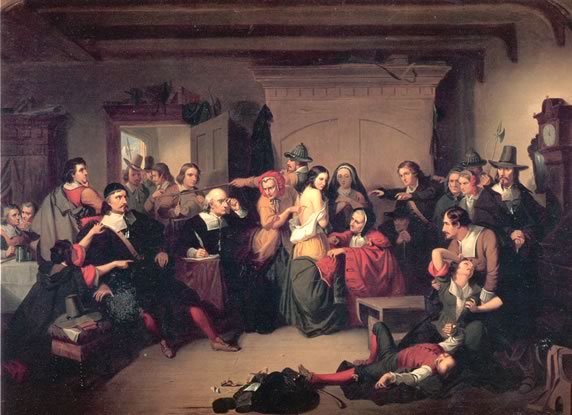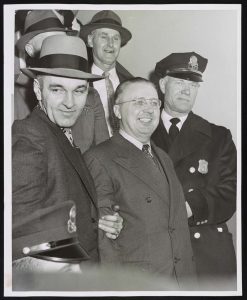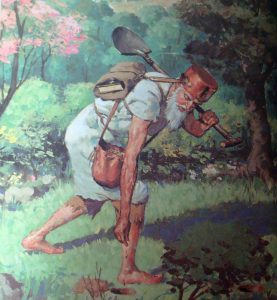Why would adults in Salem, Massachusetts in the 1690s take the accusations of nine year old girls seriously? During the seventeenth century, New England had grown diverse. The people living in the communities were of different backgrounds. But in the 1690’s there was an apparent outbreak of witchcraft. The most famous of these outbreaks was the event in Salem, Massachusetts in 1692 that stirred up the Salem community and soon spread to other communities.
The widespread hysteria over witches was all over the town after an accusation of witchcraft was made in January 1692. A group of young adolescent girls met in the home of Samuel Parris, a Puritan pastor in Salem. The pastor had a nine year old daughter, Betty. Betty and her cousin Abigail were fascinated by the voodoo tales and tricks told to them by the family slave. The family slave, Tituba, was the one whom the little girls had sought after for entertainment.1 It was not long after their time spent with Tituba, when the girls began to behave strangely; seeing visions, babbling at times, and lapsing into trances. The Puritans thought that these behaviors were of witchcraft, as the work of the devil. People in Salem began believing the girls, and charged Tituba and two other village women for practicing witchcraft on them. Two men, John Hathorne and Johnathan Corwin of Massachusetts, were called to do a legal examination of the women. The Puritans followed the Old Testament law. This was how they assessed the examinations. Scripture had a statement that said witches were not able to live. The two men knew exactly what they had to do. The examination was done on these women of Salem by looking for a certain mark on the body: a wart or tit. This specific mark was said to be the place where the devil and his demons would take blood out of the witch.2 Many of the women accused were of lower status in the community.

Research shows most of the accused witches were middle-aged women, widowed, with few or no children. Also, if the woman had been involved with domestic conflicts, they were accused. The women were accused of crimes and appeared to be dangerous by their neighbors. Women in Salem who inherited or possessed land were also accused of witchcraft.3 The accusations towards these women were out of the ordinary and seemingly wrong. One must first think about the view of women during this time. They were undermined and portrayed as having no power or knowledge of such things; they were subservient to the men in the community. Not only were low class women accused of witchcraft, but as time passed, superior women were accused as well.4
On October 29th, the Salem Witch Trials were called to an end. Governor Phips dismissed the Court and that marked the end to the witch hunt craze. Many were disappointed about the ending of the trials, but many were glad to return to work.5 The community in Salem blamed Pastor Parris for letting the innocent die. The people of the Salem church also voted to void his salary. In the following years, those family members of the deceased were restored their good names. The families were awarded a compensation for all the financial loses they went through during such tragic times. Increase Mather, a pastor of the Boston Puritan Church, wanted the people to do away with the court because he believed they put innocent people to death.
The Witch trials took on an important role in American History. The trials became a tragic and memorable moment in history. Generational, racial, and sexual hostility, opposition to law, social stresses, and food poisoning were all causes as to why the people had anxieties that found release in the witch hunt craze. The witch hunts became searches for scapegoats; the community leaders were looking for anyway possible to ease the community’s anxieties.6
- Kenneth P. Minkema, “In the Devil’s Snare: The Salem Witchcraft Crisis of 1692,” The Christian Century, no. 8 (2003): 37. ↵
- Salem Press Encyclopedia, January 2015, s.v. “Salem Witchcraft Trials,” by Warren M. Billings and Kimberly Manning. ↵
- Alan Brinkley, American History, 15th ed., vol. 1: to 1865 (2 Penn Plaza, New York, NY 10121: McGraw Hill Education, 2015), 86-87. ↵
- Salem Press Encyclopedia, January 2015 s.v. “Salem Witchcraft Trials,” by Warren M. Billings, Kimberly Manning. ↵
- Salem Press Encyclopedia, January 2015 s.v. “Salem Witchcraft Trials,” by Warren M. Billings, Kimberly Manning. ↵
- Salem Press Encyclopedia, January 2015 s.v. “Salem Witchcraft Trials,” by Warren M. Billings and Kimberly Manning. ↵



178 comments
Marissa Gonzalez
I enjoyed reading this article because to me, it is such an interesting topic since you do not hear much about witchcraft in history. This is probably why the Salem witch trials are a popular event in American history. I find it interesting how the Pastor was blamed for putting these innocent women to death because of their involvement with witchcraft. I was even more surprised on the reaction that arose to this by voiding his salary. Great job on this article!
Tyler Sleeter
A great example of a male dominated culture keeping females in line. Women were accused of being witches for many reasons and had almost no way to defend themselves against these accusations. It is a shameful part of our American past. This is the first time I had heard that victim’s families were compensated for their misfortune and had their family names restored.
Aaron Mcglown
Very cool article Oscar. It was a very informative and interesting. Back in high school this was one of my favorite topics. I was always intrigued on how a group of girls could cause so much trouble. To me this is a huge part of history and how you depicted it was awesome. Keep up the good work and I’m looking forward to more articles.
Aaron Mcglown
Very interesting! I honestly knew nothing about the salem trials. it was cool to find out that it all started with 2 young girls and that the families were reimbursed for their lost ones who passed. Still in shock that 2 girls shook a whole settlement the way they did and caused a major part of history.
Nataly Solis Chavez
Although I didn’t know very much about this topic before reading this it fascinated me! I especially enjoyed how you the organization of your article, it made things easy to follow and understand as they went along. The visuals make a great difference as well. I had no idea people were reimbursed during this era! How unfortunate to see something like this occur in history but you did a great job of mentioning some of the aftermath of the Salem Witch Trials, well done!
Gabriela Serrato
I loved that the idea of the scapegoat was added into this article. Because while the witch trials do get spoken about, it is true that women were simply targeted to “ease anxieties.” It was interesting to read that because of women’s low representation and thought of as being less respected then men, they were tried and killed to provide an answer that solved nothing. It is sad to see the persecution of women having such a largely supported and popular approval.
Lianna Ybarra
I particularly like this topic, it has always interested me whenever we talk about it in class. The article was well written and had really good background information that was helpful if you didn’t really know much about the witchcraft trials. I think it’s interesting that to this day we still don’t know what caused these girls to have these outbreaks. I personally think they were just doing it for the attention and for the pleasure of knowing they had so much power. I am glad though that they did call these trials off because it did kill many innocent people.
Mario Sosa
A dark period of time for colonial America. I had often wondered why so many people were extremely paranoid during the time of the witch trials. It is almost hard to believe that people would use the witch hunt as an excuse to accuse the people that they hate. It had to have been rough to live as a middle aged woman living alone at that time. Great article!
Zaraly Frasquillo Bejarano
In high school I took a course called Literature and the Law, and we acted out some of the trials in a real life court trial (hopefully that makes sense) and it was always crazy to believe how 9 little girls made such a great impact. Reading this article brought back so many memories, and it was easy to understand. Great job!
Aaron Jaramillo
Interesting article Oscar. It was very informative and has a good flow. I remember back in high school I was always fascinated with the witches in Salem. I find it interesting and odd that a group of girls could turn a community upside down. This is an important part of history and your resources helped you retell what happened in Salem. Good job!